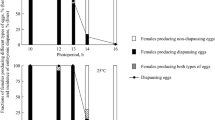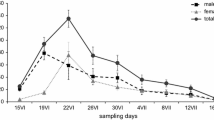Summary
Three species of Membracidae (Homoptera) have been found to coexist on the creosote bush, Larrea tridentata in the Mojave Desert. The insects are monophagous, univoltine and appear to avoid direct competition by temporal segregation. Multareis cornutus overwinters as slow growing nymphs and the adult population peaks in March. Centrodontus atlas overwinters in the egg stage with rapidly growing nymphs appearing in March while the adult population peaks in June. Multareoides bifurcatus overwinters as adults with the adult population peak in July. Nymphs occur in May–June. The various species have evolved cryptic form and coloration which is associated with phenology of the host plant. It is postulated that this has contributed to the evolution of temporal segregation.
Similar content being viewed by others
References
Ackerman TL, Romney EM, Wallace A, Kinnear JE (1980) Phenology of Desert Shrubs in Southern Nye County, Nevada. Great Basin Nat Mem 4:4–23
Cook P, Jr (1952) A Study of the Membracid Genus Centrodontus (Homoptera). J Kan Ent Soc 25 (3):92–103
Cook P, Jr (1953) The Membracid Genus Multareis and a New Genus, Multareoides (Homontera). J Kan Ent Soc 26 (3):78–94
Goding FW (1892) Studies in North American Membracidae —II. Ent News 3 (8):201
Goding FW (1895) Studies in North American Membracidae—III. Can Ent 72 (10):274–275
Mabry TJ, Hunziker JH, DiFeo DR, Jr (1977) Creosote Bush. Biology and Chemistry of Larrea in New World Deserts. US/IBP Synthesis Series-6. Dowden, Hutchinson & Ross, Inc., Stroudsburg, Penn
McClure MD, Price PW (1975) Competition Among Sympatric Erythroneura Leafhoppers (Homptera: Cicadellidae) on American Sycamore. Ecology 56:1388–1397
Mispagel ME (1974) An Ecological Analysis of Insect Populations of Larrea tridentata in the Mojave Desert. M.S. Thesis, California State University, Long Beach
Shiff CJ, Stave ME (in prep) Insect Ecology of the Creosote Bush, Larrea tridentata Coville in the Mojave Desert of Southern California
Thornhill R (1980) Competition and Coexistence Among Panorpa Scorpionflies (Mecoptera: Panorpidae).Ecological Monographs 50 (2):179–197
Turner FB (ed) (1979) Ecological Baseline Studies at the Site of the Barstow 10 MWE Pilot Solar Thermal Power System. U.S. DOE report DE-AM03-76-SF00012
Waloff N (1979) Partitioning of Resources by Grassland Leafhoppers (Auchenorrhyncha, Homoptera). Ecol Ent 4:379–385
Wood TK (1979) Sociality in the Membracidae (Homoptera). Misc Publ Ent Soc Am 11 (3):15–22
Author information
Authors and Affiliations
Additional information
Study supported by Contract DE-AM03-76-SF00012 between the U.S. Department of Energy and the University of California, USA
Rights and permissions
About this article
Cite this article
Stave, M.E., Shiff, C.J. Temporal segregation in North American desert Membracidae. Oecologia 51, 408–411 (1981). https://doi.org/10.1007/BF00540914
Received:
Issue Date:
DOI: https://doi.org/10.1007/BF00540914




